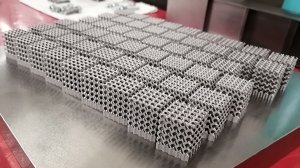Researchers conclude that fatigue issues regarding 3D printed parts can now be handled


Titanium metal lattice cubes produced by additive manufacturing
Photo by Central University of Technology
Researchers from South Africa, Italy, Norway and the US have jointly written a review article for the prestigious journal Materials Science and Engineering R, in which they argue that concerns about the structural integrity of metal cellular structures created by additive manufacturing (AM), although valid, can now be addressed. AM is popularly called 3D printing, and refers to the creation of objects directly from 3D computer models by means of joining materials, usually by using heat or lasers to build the objects up layer by layer from powered materials, including metals.
“Many potential manufacturing errors can occur … with especially poor fatigue properties often found,” stated the research team in the abstract of their paper (entitled “Architected cellular materials: A review on their mechanical properties towards fatigue-tolerant design and fabrication”). “These have improved over the years, matching the maturation and improvement of the metal [AM] processes. As the causes of errors and effects of these on mechanical properties are now better understood, many of the underlying issues can be removed or mitigated.”
Fatigue is the most significant mechanism in causing structural failure. It is caused by the continued application and relaxation of loading forces which, over time, create cracks. It is of the utmost importance to prevent this, especially in high-performance components, such as those found in the aerospace, automotive and medical implant sectors.
The study was specifically focused on the mechanical properties and fatigue performance of porous metallic cellular (or lattice) structures produced through AM. Such structures are complex; they have large surface areas, regular repeated structures, low mass, and open interconnected spaces. AM allows the micro-architecture of these structures to be optimised regarding shape, stiffness, strength and weight, so that they can be tailored (or, in the jargon, ‘architected’) for specific mechanical or other performance requirements. They are especially useful for medical implant applications, because they can be used to make complex individualised designs, they are light but long-lasting, and their porous metallic structures allow ‘bone in-growth’ into the implant, strengthening the attachment.
“Fully understanding fatigue performance makes it possible to mitigate potential problems, which opens up the possibilities for using this [AM] technology in many more applications,” pointed out Stellenbosch University Physics Department Associate Professor and South African study co-author Anton du Plessis. “Fatigue failure is often driven by defects, microstructural imperfections, residual stresses, surface roughness, and, as this review has also highlighted, strut junctions in lattice structures.”
“But it has been proven that excellent properties can be achieved by considering all the above factors, and that some cellular architectures are better suited to achieve high-fatigue performance,” he affirmed. “We believe the growing knowledge base in this area will allow a better understanding of these meta-materials and specifically on how to achieve best performance from them, for various new applications. It is clear that many new applications of these structures are waiting to be revealed in different industries and application areas.”
Comments
Press Office
Announcements
What's On
Subscribe to improve your user experience...
Option 1 (equivalent of R125 a month):
Receive a weekly copy of Creamer Media's Engineering News & Mining Weekly magazine
(print copy for those in South Africa and e-magazine for those outside of South Africa)
Receive daily email newsletters
Access to full search results
Access archive of magazine back copies
Access to Projects in Progress
Access to ONE Research Report of your choice in PDF format
Option 2 (equivalent of R375 a month):
All benefits from Option 1
PLUS
Access to Creamer Media's Research Channel Africa for ALL Research Reports, in PDF format, on various industrial and mining sectors
including Electricity; Water; Energy Transition; Hydrogen; Roads, Rail and Ports; Coal; Gold; Platinum; Battery Metals; etc.
Already a subscriber?
Forgotten your password?
Receive weekly copy of Creamer Media's Engineering News & Mining Weekly magazine (print copy for those in South Africa and e-magazine for those outside of South Africa)
➕
Recieve daily email newsletters
➕
Access to full search results
➕
Access archive of magazine back copies
➕
Access to Projects in Progress
➕
Access to ONE Research Report of your choice in PDF format
RESEARCH CHANNEL AFRICA
R4500 (equivalent of R375 a month)
SUBSCRIBEAll benefits from Option 1
➕
Access to Creamer Media's Research Channel Africa for ALL Research Reports on various industrial and mining sectors, in PDF format, including on:
Electricity
➕
Water
➕
Energy Transition
➕
Hydrogen
➕
Roads, Rail and Ports
➕
Coal
➕
Gold
➕
Platinum
➕
Battery Metals
➕
etc.
Receive all benefits from Option 1 or Option 2 delivered to numerous people at your company
➕
Multiple User names and Passwords for simultaneous log-ins
➕
Intranet integration access to all in your organisation



















